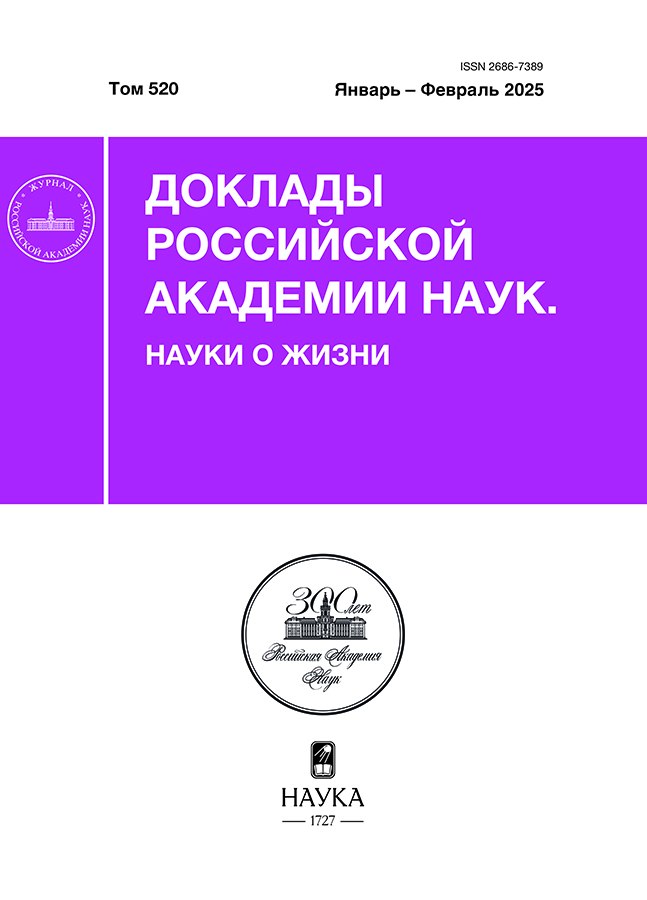Analgesic activity of the low molecular weight neurotrophin-3 dipeptide mimetic GTS-301
- Авторлар: Kolik L.G.1, Konstantinopolsky M.A.1, Sazonova N.M.1, Durnev A.D.1, Gudasheva T.A.1
-
Мекемелер:
- FSBSI “Federal Research Center for Innovator and Emerging Biomedical and Pharmaceutical Technologies”
- Шығарылым: Том 520, № 1 (2025)
- Беттер: 100-103
- Бөлім: Articles
- URL: https://cijournal.ru/2686-7389/article/view/682051
- DOI: https://doi.org/10.31857/S2686738925010166
- EDN: https://elibrary.ru/tcgjna
- ID: 682051
Дәйексөз келтіру
Аннотация
It was previously shown that the original dipeptide mimetic of the 4th loop neurotrophin-3 (NT-3) hexamethylenediamide bis-(N-monosuccinyl-L-asparaginyl-L-asparagine) (GTS-301), like full-size neurotrophin, predominantly activates the tyrosine kinase receptor TrkC and has a neuroprotective effect in vitro at concentrations of 10-5-10-12 M, as well as after systemic administration on rodents – antidiabetic (0.1 and 0.5 mg/kg) and antidepressant (5 and 10 mg/kg) effects. In this work, the analgesic properties of GTS-301 were identified, which were manifested in the dose range of 0.01-10 mg/kg after acute intraperitoneal injection to rats in the “tail flick” test. Dipeptide GTS-301 increased the threshold of pain response by 20-30% and the effect persisted for at least 24 hours after administration.
Толық мәтін
Авторлар туралы
L. Kolik
FSBSI “Federal Research Center for Innovator and Emerging Biomedical and Pharmaceutical Technologies”
Хат алмасуға жауапты Автор.
Email: kolik_lg@academpharm.ru
Ресей, Moscow
M. Konstantinopolsky
FSBSI “Federal Research Center for Innovator and Emerging Biomedical and Pharmaceutical Technologies”
Email: kolik_lg@academpharm.ru
Ресей, Moscow
N. Sazonova
FSBSI “Federal Research Center for Innovator and Emerging Biomedical and Pharmaceutical Technologies”
Email: kolik_lg@academpharm.ru
Ресей, Moscow
A. Durnev
FSBSI “Federal Research Center for Innovator and Emerging Biomedical and Pharmaceutical Technologies”
Email: kolik_lg@academpharm.ru
Сorresponding Мember of the RAS
Ресей, MoscowT. Gudasheva
FSBSI “Federal Research Center for Innovator and Emerging Biomedical and Pharmaceutical Technologies”
Email: kolik_lg@academpharm.ru
Сorresponding Мember of the RAS
Ресей, MoscowӘдебиет тізімі
- Hohn A., Leibrock J., Bailey K., et al. // Nature. 1990. V. 344. P. 339–341.
- Rosenthal A., Goeddel D.V., Nguyen T., et al. // Neuron. 1990. V. 4. P. 767–773.
- Siuciak J. A., Altar A., Wiegand S. J., et al. // Brain Res. 1994. V. 633, № 1–2. P. 326–330.
- Malcangio M., Garrett N. E., Cruwys S., et al. // J. Neurosci. 1997. V. 17. № 21. P. 8459.
- Watanabe M., Endo Y., Kimoto K., et al. // Neurosci. Lett. 2000. V. 1–2. № 282. P. 61–64.
- Wilson-Gerwing T.D., Dmyterko M.V., Zochodne D.W., et al. // J. Neurosci. 2005. V. 25. № 3. P. 758–767.
- Gudasheva T.A., Povarnina P.Y., Tarasiuk A.V., et al. // Med Res Rev. 2021. V. 41. № 5. P. 2746-2774. doi: 10.1002/med.21721.
- Гудашева Т.А., Сазонова Н.М., Тарасюк А.В., и др. // ДАН. 2022. Т. 505. № 1. С. 303-309.
- Ягубова С.С., Чернышевская М.А., Островская Р.У., и др. // ДАН. 2023. Т. 512.
- Hardy J.D., Wolff H.G. and Goodell H. // J Clin Invest. 1940. V. 19. P.649–657.
- Bannon A.W., Malmberg A.B. // Curr Protoc Neurosci. 2007. Chapter 8:Unit 8.9.
- Douglas D.K. and Carstens E. // J Neurophysiol. 1997. V. 77. P. 611–620.
- Maisonpierre P.C., Belluscio L., Friedman B., et al. // Neuron. 1990. V. 5. P. 501–509.
- Ernfors P., Rosario C.M., Merlio J.P., et al. // Brain Res. Mol. Brain Res. 1993. V.17. P. 217–226.
- Гудашева Т.А., Константинопольский М.А., Тарасюк А.В., и др. // ДАН. 2019. Т. 485. № 3. С. 366–369.
- Helgren M.E, Cliffer K.D., Torrento K., et al. // J. Neurosci. 1997. V. 17. P. 372–382.
- Sahenk Z., Nagaraja H.N., McCracken B.S., et al. // Neurology. 2005. V. 65. P. 681–689.
- Степанова О.В., Воронова А.Д., Чадин А.В., и др. // Клеточные технологии в биологии и медицине. 2022. Т. 1. С. 3–8.
Қосымша файлдар











